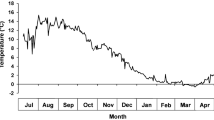Abstract
Green sea urchin, Strongylocentrotus droebachiensis (O.F. Müller), populations are being depleted rapidly in the Gulf of Maine and there is justified concern that the potential of this free-spawner to produce larvae may be severely inhibited. We evaluated the opposing effects of different population densities on gonad development and fertilization success, using population surveys and fertilization experiments. We determined gonad indices (gonad mass/body mass) over a range of population densities (0.1 to 250 ind. m−2) at seven sites in coastal Maine, USA, sampled at two depths (5 and 15 m). At shallow sites, we found that gonad indices declined by 50% over the 1500-fold range in adult population density. At 15 m deep locations, gonad mass was consistently low and did not vary significantly with density. Patterns of macroalgal abundance suggest urchins at high density and in deeper water were food limited. Because macroalgal cover co-varies inversely with sea urchin density, we designed field experiments to determine the interaction between sea urchin density and kelp canopy on fertilization success. On square arrays we manipulated the spacing of simulated urchins, but held their numbers constant (five sperm-filled syringes interspersed with four Nitex mesh egg containers permeable to sperm). These experiments, simulating the observed range of natural density, suggested that (1) fertilization rates decreased many times faster than individual gamete production increased over the same range in density, and (2) kelp increased fertilization success at high density when eggs were within 25 cm of a sperm source, but not when spaced 1 m apart. Additional laboratory fertilization experiments at ambient temperatures (3 to 5 °C) indicated that diluted sperm were viable for <1 h, but egg viability was virtually unchanged for >8 h. In short, to the individual the reproductive benefits of aggregating appear to outweigh the costs; and while sperm may be limiting at low population density, eggs may remain viable long enough to be fertilized by sperm from more distant males.
Similar content being viewed by others
Author information
Authors and Affiliations
Additional information
Received: 10 February 1998 / Accepted: 22 January 1999
Rights and permissions
About this article
Cite this article
Wahle, R., Peckham, S. Density-related reproductive trade-offs in the green sea urchin, Strongylocentrotus droebachiensis. Marine Biology 134, 127–137 (1999). https://doi.org/10.1007/s002270050531
Issue Date:
DOI: https://doi.org/10.1007/s002270050531




